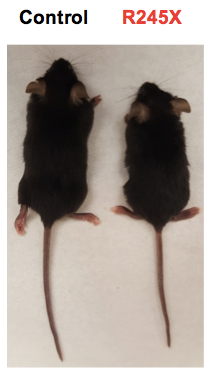
By Zubair Ahmed, Ph.D.
Zubair Ahmed, Ph.D., has been researching Usher 1F for many years. He was a post doctoral student and part of the team at the NIH that, in 2002, discovered the most common genetic mutation that causes Usher 1F. After several attempts, he has now succeeded where several others have failed in creating a mouse model of this mutation that provides us with a major breakthrough in testing potential treatments and therapies for the vision loss of Usher 1F. He describes his work for us.
Through genome manipulation, we have generated a Pcdh15 R245X mouse strain (Fig. 1). Cataloguing of the natural history of vision, hearing, balance loss, and associated pathophysiology in Pcdh15 R245X mice is vital to determine the success of any future intervention strategies in patients affected with USH1F. Our current data suggest that the Pcdh15 mutant mice are profoundly deaf by birth, and have serious vestibular dysfunction as they cannot swim properly and have a strong stereotypic circling behaviour. At the cellular level, we have determined that the sensory hair cells of the cochlea and the vestibular system are not functional and degenerate rapidly after birth (Fig. 2). The mice also progressively lose vision, which means that we finally have a mouse model in our hand to understand the role of Pcdh15 in the maintenance of vision in USH1F (Fig. 3), and to evaluate therapeutic strategies. In collaboration with Dr. Livia Carvalho (Lions Eye Institute, Perth, Australia), and Dr. Luk Vandenberghe (Harvard Medical School, and Massachusetts Eye and Ear, Boston, USA), we are developing gene therapy strategies to replace the impaired Pcdh15 gene and also testing different compounds to reverse the hearing, balance and vision impairment in this R245X mouse model. Funding from the Usher 1F Collaborative has been instrumental in developing and characterizing the R245X mouse model.

